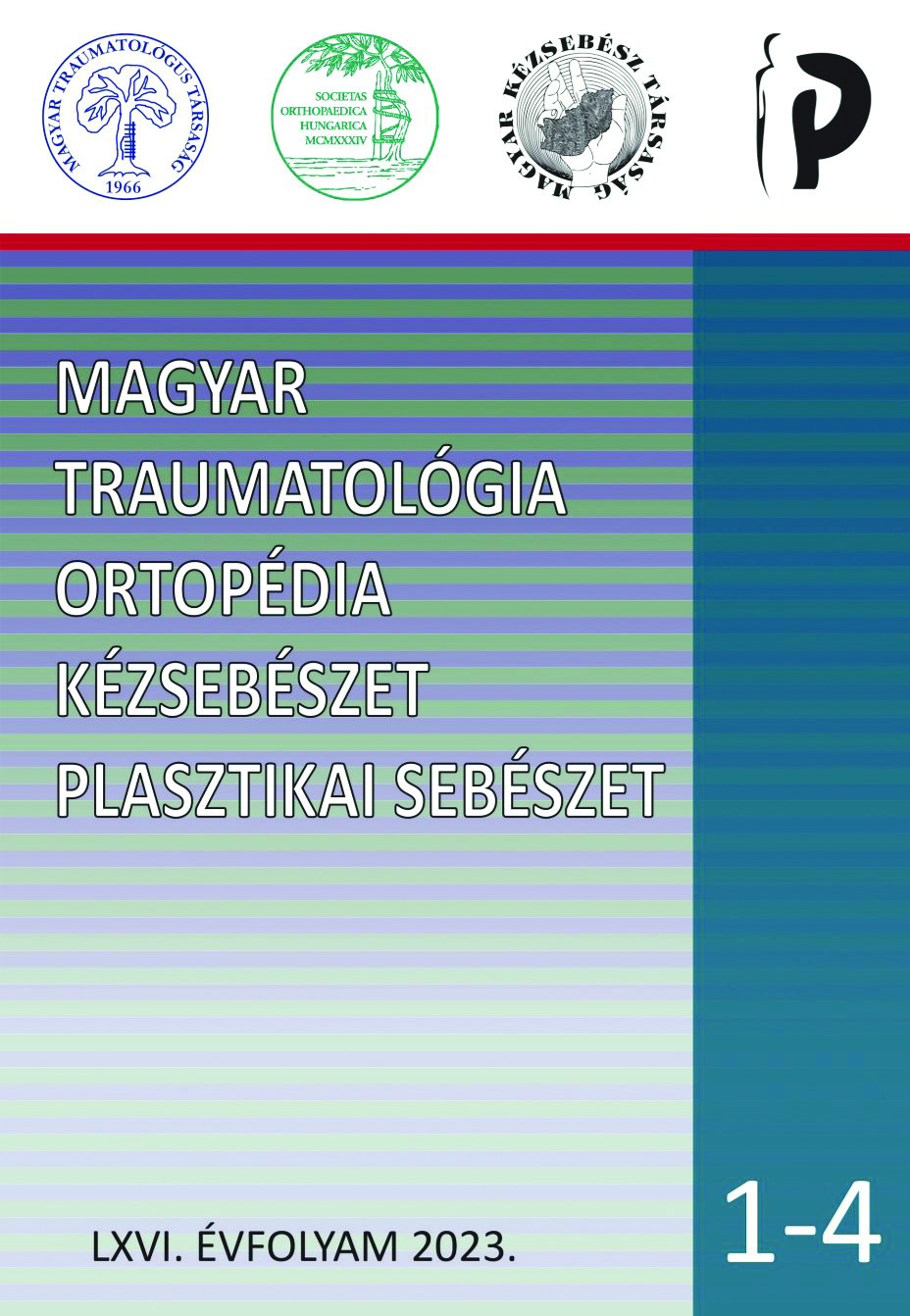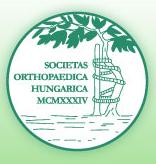"Greater arc injuries" - literature review in connection with a case report
Abstract
Perilunate dislocations and fracture–dislocations are rare injuries, however, even if proper operative treatment and postoperative aftercare is performed, it is difficult to achieve good results. Greater arc injury is a fracture-dislocation pattern of injury involving the perilunate carpal bones and in some cases the radius with ligament damage; thereby damaging the biomechanical complex of the wrist. However, given that these injuries affect the young population active in work and sports, the aim is to restore the biomechanics, the range of motion and the loading capacity of the wrist, without leaving any pre-arthrotic elements behind. The authors review presents the etiology, incidence and main diagnostic (X-ray and CT) signs of the disorder, and its surgical treatment, postoperative fixation and rehabilitation methods. In addition to the case presentation of a 24-year-old male patient, questionable points of the care process and points that can be optimized are discussed in relation to his daily care.
References
Bain GI, McLean JM, Turner PC, Sood A, Pourgiezis N. Translunate fracture with associated perilunate injury: 3 case reports with introduction of the translunate arc concept. J Hand Surg Am. 2008. 33(10): 1770-1776. https://doi.org/10.1016/j.jhsa.2008.06.017
Berger RA. A method of defining palpable landmarks for the ligament-splitting dorsal wrist capsulotomy. J Hand Surg Am. 2007. 32(8): 1291-1295. https://doi.org/10.1016/j.jhsa.2007.07.023
Forli A, Courvoisier A, Wimsey S, Corcella D, Moutet F. Perilunate dislocations and transscaphoid perilunate fracture-dislocations: a retrospective study with minimum ten-year follow-up. J Hand Surg Am. 2010. 35(1): 62-68. https://doi.org/10.1016/j.jhsa.2009.09.003
Garcia–Elias M., Lunch AL. Wrist instabilities, misalignments, and dislocations. In: Scott W. Wolfe, William C. Pederson, Scott H. Kozin, Mark S. Cohen. Green's operative hand surgery. 7th Ed. Philadelphia, Elsevier, 2017. 418-478. p.
Herzberg G, Comtet JJ, Linscheid RL, Amadio PC, Cooney WP, Stalder J. Perilunate dislocations and fracture-dislocations: a multicenter study. J Hand Surg Am. 1993. 18(5): 768-779. https://doi.org/10.1016/0363-5023(93)90041-Z
Johnson RP. The acutely injured wrist and its residuals. Clin Orthop Relat Res. 1980. (149): 33-44. https://doi.org/10.1097/00003086-198006000-00005
Kardashian G, Christoforou DC, Lee SK. Perilunate dislocations. Bull NYU Hosp Jt Dis. 2011. 69(1): 87-96.
Knoll VD, Allan C, Trumble TE. Trans-scaphoid perilunate fracture dislocations: results of screw fixation of the scaphoid and lunotriquetral repair with a dorsal approach. J Hand Surg Am. 2005. 30(6): 1145-1152. Erratum in: J Hand Surg Am. 2006. 31(2): 328. https://doi.org/10.1016/j.jhsa.2005.07.007
Komurcu M, Kürklü M, Ozturan KE, Mahirogullari M, Basbozkurt M. Early and delayed treatment of dorsal transscaphoid perilunate fracture-dislocations. J Orthop Trauma. 2008. 22(8): 535-540. https://doi.org/10.1097/BOT.0b013e318183eb23
Kremer T, Riedel K., Perilunate dislocations. In: Garcia-Elias M., Mathoulin C.: Articular injury of the wrist. FESSH 2014 Instructional Course Book. New York. Thieme. 2014. 53-60. p
Kremer T, Wendt M, Riedel K, Sauerbier M, Germann G, Bickert B. Open reduction for perilunate injuries. Clinical outcome and patient satisfaction. J Hand Surg Am. 2010. 35(10): 1599-1606. https://doi.org/10.1016/j.jhsa.2010.06.021
Mayfield JK, Johnson RP, Kilcoyne RK. Carpal dislocations: pathomechanics and progressive perilunar instability. J Hand Surg Am. 1980. 5(3): 226-241. https://doi.org/10.1016/S0363-5023(80)80007-4
Ramponi DR, Good AE. Perilunate and lunate dislocations. Adv Emerg Nurs J. 2023. 45(2): 119-122. https://doi.org/10.1097/TME.0000000000000453
Sandoval E, Cecilia D, Garcia-Paredero E. Surgical treatment of trans-scaphoid, transcapitate, transtriquetral, perilunate fracture-dislocation with open reduction, internal fixation and lunotriquetral ligament repair. J Hand Surg Eur. 2008. 33(3): 377-379. https://doi.org/10.1177/1753193408089531
Scalcione LR, Gimber LH, Ho AM, Johnston SS, Sheppard JE, Taljanovic MS. Spectrum of carpal dislocations and fracture-dislocations: Imaging and management. Am J Roentgenol. 2014. 203(3): 541-550. https://doi.org/10.2214/AJR.13.11680
Severo AL, Lemos MB, Pereira TAP, Fajardo RDP, Maia PEC, Lech O. Trans-scaphoid perilunate fracture dislocation beyond Mayfield stage IV: a case report on a new classification proposal. Rev Bras Ortop. 2017. 53(5): 643-646. https://doi.org/10.1016/j.rboe.2017.05.008
Shivanna D, Manjunath D, Amaravathi R. Greater arch injuries. J Hand Microsurg. 2014. 6(2): 69-73. https://doi.org/10.1007/s12593-014-0143-5
van der Oest MJW, Duraku LS, Artan M, Hundepool CA, Power DM, Rajaratnam V, Zuidam JM. Perilunate injury timing and treatment options: A systematic review. J Wrist Surg. 2021. 11(2): 164-176. https://doi.org/10.1055/s-0041-1735841
Zolczer L, Nemes J, Glanz J. A kéztőízület instabilitása (funkcionális anatómia, instabilitási formák, diagnosztika) [Instability of the wrist joint (functional anatomy, forms of instability, diagnosis)]. Hungarian. Magy. Traumatol. Orthop. Helyreallito Seb. 1988. 31. (4): 267-276.











